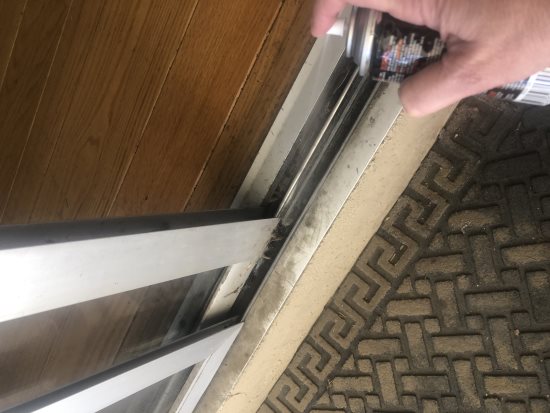 | | | Tri-Flow can be used to fix a sticking sliding glass door. Photo J. Wake | | | | | | When the key stopped working on the driver side door of my old Ford Ranger, after 10 years and 175,000 miles, I called the dealer's parts counter to ask about replacing the lock. "Don't do that yet," the Parts-Guy said, "Get a can of Tri-Flow and spray the heck out of the lock." (I think we all understand that he did not literally say "heck.") Tri-Flow, what an epiphany! I had already sprayed the lock several times with the ever-popular WD-40. The first time it worked OK for a bit, the second time not so much, the third time had me calling the Parts-Guy. Tri-Flow worked beautifully and the lock worked for another two years.
 Tri-Flow versus WD-40; aren't they the same? Not really.
Tri-Flow versus WD-40; aren't they the same? Not really.
 Thanks to great marketing, WD-40 has become a household name. By the way, WD-40 stands for Water Displacement - 40. It was the 40th version in a series of the manufacturer's experimental formulas. It is basically a silicone and oil lubricant combined with a spray propellant intended to repel water, and leave a rust reducing film. It works very well at that. The downside to WD-40 is that it tends to collect dust forming a sticky sort of grime that eventually contributes to the friction, rather than reducing it. Initially bicyclists loved to spray their bike chain and gears with WD-40 to help them go faster. What they found was that the accumulated grime actually wore out the chains and gears faster.
Thanks to great marketing, WD-40 has become a household name. By the way, WD-40 stands for Water Displacement - 40. It was the 40th version in a series of the manufacturer's experimental formulas. It is basically a silicone and oil lubricant combined with a spray propellant intended to repel water, and leave a rust reducing film. It works very well at that. The downside to WD-40 is that it tends to collect dust forming a sticky sort of grime that eventually contributes to the friction, rather than reducing it. Initially bicyclists loved to spray their bike chain and gears with WD-40 to help them go faster. What they found was that the accumulated grime actually wore out the chains and gears faster.
 Tri-Flow is a Teflon-based lubricant which repels dust as well as water. It sprays on much the same as the other stuff but works better at loosening sticky parts and keeps things cleaner. Unlike the silicone in WD-40, the Teflon in Tri-Flow tends to settle in the solution, so you need to shake the can before you spray. If you can't find Tri-Flow at your local hardware store, check the bike shop. Bicyclists love this stuff. I don't carry WD-40 in my tool kit anymore; Tri-Flow is much more versatile.
Tri-Flow is a Teflon-based lubricant which repels dust as well as water. It sprays on much the same as the other stuff but works better at loosening sticky parts and keeps things cleaner. Unlike the silicone in WD-40, the Teflon in Tri-Flow tends to settle in the solution, so you need to shake the can before you spray. If you can't find Tri-Flow at your local hardware store, check the bike shop. Bicyclists love this stuff. I don't carry WD-40 in my tool kit anymore; Tri-Flow is much more versatile.
 Now that we've fixed your squeaky hinges and sticky locks, let's talk about sticky doors. One of the most common calls I get in the Lamorinda area is about doors that don't open or shut easily. There are several reasons why this happens. (I may have another article about that later.) But one common problem is that the jamb has slightly shifted just enough that the door is tight against it. The best lubricant I've found for that bind is paraffin wax. Some people use candles, but I buy blocks of paraffin wax that are sold with canning supplies in the housewares department of hardware stores and better grocery stores. Rub the paraffin along the edges of the door (or window) and the jamb: you won't see it, but it works wonderfully to reduce friction. I rub paraffin on the bottom edges of old dresser drawers to help them slide (new furniture has metal rollers). It will also quiet a noisy fan belt on your car. Do Teslas have fan belts or am I dating myself?
Now that we've fixed your squeaky hinges and sticky locks, let's talk about sticky doors. One of the most common calls I get in the Lamorinda area is about doors that don't open or shut easily. There are several reasons why this happens. (I may have another article about that later.) But one common problem is that the jamb has slightly shifted just enough that the door is tight against it. The best lubricant I've found for that bind is paraffin wax. Some people use candles, but I buy blocks of paraffin wax that are sold with canning supplies in the housewares department of hardware stores and better grocery stores. Rub the paraffin along the edges of the door (or window) and the jamb: you won't see it, but it works wonderfully to reduce friction. I rub paraffin on the bottom edges of old dresser drawers to help them slide (new furniture has metal rollers). It will also quiet a noisy fan belt on your car. Do Teslas have fan belts or am I dating myself?
 Tri-Flow and paraffin wax can help relieve much of the unwanted friction in your life. I recommend practical mindfulness and meditation for the rest.
Tri-Flow and paraffin wax can help relieve much of the unwanted friction in your life. I recommend practical mindfulness and meditation for the rest. |

